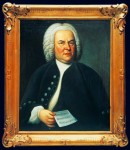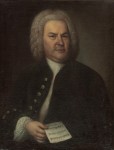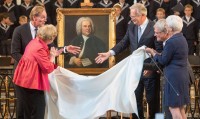 The most famous and best-preserved portrait of composer Johann Sebastian Bach has returned home to Leipzig after an absence of at least more than a century, possibly two. It was painted in Leipzig by Elias Gottlob Haussmann in 1748, the second of two virtually identical portraits he made of the Baroque composer. The first iteration, painted in 1746 and now in the Stadtgeschichtlichen Museum Leipzig, was damaged by excessive cleaning and overpainting particularly on the face. With the exception of a small overpainted area of the background, the 1748 Haussmann portrait is entirely original. The colors are vibrant and rich. The difference is so pronounced that the 1748 portrait is considered to be the sole authentic depiction of Bach’s facial features.
The most famous and best-preserved portrait of composer Johann Sebastian Bach has returned home to Leipzig after an absence of at least more than a century, possibly two. It was painted in Leipzig by Elias Gottlob Haussmann in 1748, the second of two virtually identical portraits he made of the Baroque composer. The first iteration, painted in 1746 and now in the Stadtgeschichtlichen Museum Leipzig, was damaged by excessive cleaning and overpainting particularly on the face. With the exception of a small overpainted area of the background, the 1748 Haussmann portrait is entirely original. The colors are vibrant and rich. The difference is so pronounced that the 1748 portrait is considered to be the sole authentic depiction of Bach’s facial features.
 The Haussmann portraits are the only surviving images of Bach painted during his lifetime. They are also the only portraits commissioned by Bach. They depict him in a serious, formal pose wearing his Sunday coat and peruke and holding a sheet of music entitled “Canon triplex à 6 Voc[ibus]” (triple canon for six voices) signed “by J. S. Bach.” Bach chose not to be painted with a keyboard instrument or with a conductor’s baton, but with one of his counterpoint canons. He wanted to be immortalized as a composer, even though during his lifetime he was better known for his playing.
The Haussmann portraits are the only surviving images of Bach painted during his lifetime. They are also the only portraits commissioned by Bach. They depict him in a serious, formal pose wearing his Sunday coat and peruke and holding a sheet of music entitled “Canon triplex à 6 Voc[ibus]” (triple canon for six voices) signed “by J. S. Bach.” Bach chose not to be painted with a keyboard instrument or with a conductor’s baton, but with one of his counterpoint canons. He wanted to be immortalized as a composer, even though during his lifetime he was better known for his playing.
Before he died in 1750, Johann Sebastian gave the 1748 portrait to his son Carl Philipp Emanuel Bach. Carl died in 1788. We know the painting was still in the possession of his widow two years later because it is described in detail in a 1790 inventory of Carl’s estate. After that it’s unclear where the painting went until the 19th century when it was in the possession of the Jenke family of Breslau (present-day Wrocław, western Poland), Silesia. The family was Jewish, so in 1936 descendant Walter Jenke hastened out of Germany to Dorset where Rolf Gardiner, an old friend from their days together at a German youth camp, had a country estate. When war broke out Jenke was interned as an enemy alien on the Isle of Man; the painting stayed in Dorset out of harm’s way.
After the war, the Walter reclaimed the painting but soon had to sell it to support his family. In 1952 it was put up for auction. The buyer was oil baron, collector, philanthropist and accomplished Bach Scholar William H. Scheide who kept it in his Princeton, New Jersey, home for more than 60 years. When Scheide died at a venerable 100 years of age on November 14th, 2014, he bequeathed the painting to the Leipzig Bach Archive.
As coincidence, fate or inspiration would have it, Rolf Gardiner’s son John Eliot, who grew up under the gaze of the Haussmann portrait, would become one of the preeminent musicians and conductors of our time, renown for his performances of Baroque music on original instruments. He has published a biography of Johann Sebastian Bach and is today the president of the Leipzig Bach Archive.
 On June 12th, the opening of Leipzig’s Bach Festival, the portrait was unveiled in St. Nicholas Church by Leipzig’s mayor Burkhard Jung, Sir John Eliot Gardiner, Mr. Scheide’s widow Judith and daughter Barbara. Hundreds of dignitaries attended the event which was broadcast live on a huge screen in the city’s market square. The choir of St. Thomas Church, where Bach served as cantor for 27 years, sang to mark the joyous homecoming.
On June 12th, the opening of Leipzig’s Bach Festival, the portrait was unveiled in St. Nicholas Church by Leipzig’s mayor Burkhard Jung, Sir John Eliot Gardiner, Mr. Scheide’s widow Judith and daughter Barbara. Hundreds of dignitaries attended the event which was broadcast live on a huge screen in the city’s market square. The choir of St. Thomas Church, where Bach served as cantor for 27 years, sang to mark the joyous homecoming.
As of today, the portrait is in the Bach Archive Museum’s Treasure Room along with the only known surviving painting of Johann Sebastian’s father Johann Ambrosius Bach. In the archive’s historic 16th century building across from St. Thomas Church, the 1748 Haussmann portrait is now on permanent public display for the first time in 267 years.
I am very pleased the portrait is back where it started, especially since it is with the only known surviving painting of Johann Sebastian Bach’s father. But I wonder if lots of people ever visit Bach Archive Museum’s Treasure Room.
Somewhere — perhaps in the foreword to his Bach biography — Sir John Eliot Gardiner tells the story of his first encounter with the portrait since his childhood long before.
I was lucky to know the Scheide’s in College. I was at their house once and saw this portrait hanging off their dinner room and thought “How tacky. A copy of the Bach picture.” I was educated quite quickly!!
Thomas